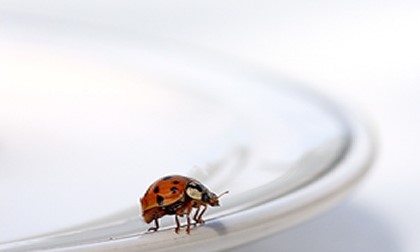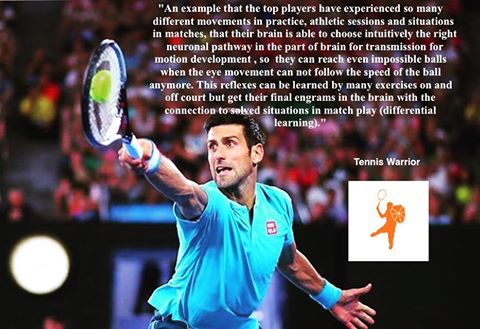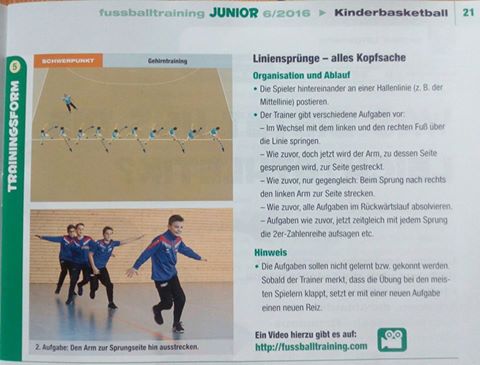Experience values as the basis of the coaching work! Very important. However, these are limited when we look at the basic conditions in our everyday training, since we have only a subjective access and only a selected group. In studies, there are always comparative groups, which we do not have, since we then have to use different methods. Also, we do not have the right measurement methods and measuring instruments. My calculation of the „Kolonnentraining“ results in a hypothesis, which actually still needs a scientific review. This is not yet scientific ;-). Believing in experience weiterlesen
Archiv für den Monat: Januar 2017
The warrior
This is a post by the engaged coach and friend of mine Dimitrios Katsanos, coaching tennis in Berlin. He describes what already Björn Borg postulated, being one of the best tennisplayers in the world in the 80s. It is a plea for „natural learning“ and meanwhile it is a confirmation for evidence based coaching. Wolfgang Schöllhorn and other scientists have shown, that implicit/differencial learning is essential for effective learning and creativity in the players game.
Schwankungen
 On our facebook page we are now at 481 Coaches and others, that follow „Inner Coaching in sports“. Thank you very much, we are hoping to reach soon the milestone of 500.
On our facebook page we are now at 481 Coaches and others, that follow „Inner Coaching in sports“. Thank you very much, we are hoping to reach soon the milestone of 500.
This is a page, on which we talk about evidence based coaching in sports. Startied from Inner Game over Inner Coaching, we are still on the way. Evidence based coaching with the backing by science.
We are surfing on a wave that pushes teaching and coaching tennis to another level.
https://www.facebook.com/innercoachingblog.de/?fref=ts
Inner Coaching 1993
„The ideas about teaching and learning have changed dramatically over the past decades. For a long time, the view was that learners had to be „filled“ with knowledge and behavior „like by a funnel“. It is not uncommon to try to force this knowledge by force. But the times of supposedly unambiguous and non-questionable movement regulations are also a thing of the past in the technology transfer.
Serious teaching methods are geared to learners, their needs and interests. The 5-time Swedish Wimbledon winner Björn Borg has asked years ago: „Do not let yourself be influenced by rigorous tennis teacher rules. Discover your individual abilities, do not be afraid to experiment with anything that will benefit your game. “
(Stefan Schaffelhuber in: Inner Coaching, 1993)
Inner Coaching 1993
„Die Vorstellungen über Lehren und Lernen haben sich in den vergangenen Jahrzehnten gravierend gewandelt. Lange herrschte die Ansicht, dass Lernende „wie durch einen Trichter“ mit Wissen und Verhaltensweisen „gefüllt“ werden müssen. Nicht selten wurde sogar versucht, dieses Wissen mit Gewalt einzuflößen. Doch die Zeiten vermeintlich eindeutiger und nicht hinterfragbarer Bewegungsvorschriften sind auch bei der Technikvermittlung in den Rückschlagspielen vorbei.
Seriöse Unterrichtsmethoden orientieren sich an den Lernenden, an deren Bedürfnissen und Interessen. Der 5-malige schwedische Wimbledonsieger Björn Borg hat schon vor Jahren gefordert: „Lass‘ Dich nicht von rigorosen Tennislehrer-Regeln beeinflussen. Entdecke lieber Deine individuellen Fähigkeiten, habe keine Angst davor, mit allem herumzuexperimentieren, das Deinem Spiel zugute kommt.“
(Stefan Schaffelhuber: Innercoaching, Frankfurt 1993
The plate’s edge
 It’s always the same question that comes up, when I’m reading and watching coaches teaching tennis. These colleagues, willing to do the best for their players, are using methods, that are absolut contradictionary to evidence based coaching.
It’s always the same question that comes up, when I’m reading and watching coaches teaching tennis. These colleagues, willing to do the best for their players, are using methods, that are absolut contradictionary to evidence based coaching.
They focus on body motion, they try to provide text-book techniques, they let players stand in a row to control the technique, and so on.
I think, there are two main problems: 1. a lot of coaches do what they „have always done“. They transport methods, they have learned in their own tennis biography. 2. coaches are tennis-coaches. Means they seldom look over the „plate’s edge“, where tehy could find so many studies about motor learning and creativity in related sports as golf, volleyball, basketball, soccer and so on.

